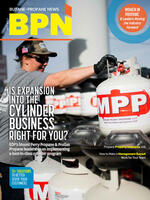
Propane distributors and their risk management professionals spend significant time and effort addressing and minimizing liability exposures associated with their operations, and rightfully so.
But often, property insurance exposures are treated as an afterthought in the process. Propane distributors make significant investment in their equipment and real estate, so insuring these assets properly should be given appropriate attention in the risk management process.
Keeping Pace With Inflation
Due to the rising cost of materials and labor, construction costs have been heavily impacted by inflation. The result of increased cost of construction means that a building or bulk plant, which was properly insured four years ago, is now potentially underinsured. It is important for a business owner to understand the potential financial risk this presents in relation to how their property insurance program is structured.
Keeping pace with inflation is an essential element of an effective risk management/insurance program. No business owner intentionally purchases more insurance coverage than necessary, but even the most well-intentioned owners can be caught off-guard by multiyear, double-digit increases in construction costs, leaving them vulnerable to unintended financial loss in the event of a property claim. After all, propane distributors are focused on their own operations and not the state of the construction industry.
There are many different approaches and philosophies to insuring property, whether it be buildings, contents, gas inventories or equipment. There is no right or wrong way to insure something, as long as the insured understands what the financial consequences of their decision will be in the event of a loss.
Many propane distributors choose to self-insure tools/equipment on service vehicles; others select very high deductibles on buildings. Each business owner should make those decisions based upon their own risk tolerance level and with their own business objectives in mind. The key to having an effective insurance program is to make an informed decision with an understanding of the options available.
Below is an outline of the very basic elements of a property insurance program.
- Valuation — There are two basic valuation options when insuring property: actual cash value (ACV) and replacement cost. Simplified, replacement cost means the insurance company pays to replace the old item for a new one. Actual cash value means the insurance company pays what the item was worth at the time of the loss (the depreciated value). On the surface, it may seem simple to always choose the replacement cost option. However, when this option is chosen, the propane distributor is required to insure their property for an amount reflecting that replacement cost, which can result in carrying substantially more insurance than was originally invested in the asset. Choosing the actual cash value option enables the policyholder to insure the asset for a value reflecting what it is worth today, rather than the much higher value to replace the item. This option obviously saves premium dollars due to purchasing less coverage, but in the event of a loss, the insured will be responsible for paying the difference to replace the item.
- Deductibles — Choosing a higher deductible can result in property insurance premium savings. If your philosophy is to absorb smaller losses and not have the impact of small claims reflected in your loss history, then make sure you are being rewarded by choosing a higher deductible and lower corresponding premium.
- Wind and hail deductibles — In many parts of the country, insurance companies impose a separate wind and hail deductible. These are usually reflected as a percentage (1% to 10%). It is important to understand how these percentages apply. Most percentage deductibles apply to the amount of insurance carried, not the amount of the claim. Therefore, if you have a $500,000 building insured, subject to a 5% wind and hail deductible, the deductible is $25,000 if that structure is damaged by windstorm or hail.
- Inland marine coverage — The term “inland marine” is a leftover from the insurance industry’s historical beginnings covering sailing ships and their cargo. Once the cargo was unloaded from the arriving ship, it could then be insured separately once it was inland. For today’s relevance, inland marine coverage differs from standard property insurance in that the property insured moves around and is not affixed to a single location. Tools and equipment (trenching equipment) carried by service vehicles are covered under an inland marine policy because it leaves the insured premises with the vehicle.
- Bulk plants — Gas storage facilities pose a particularly challenging dilemma for the propane distributor. Due to the nature of propane bulk storage tanks, many are refurbished several times throughout the life of the tank. It is not uncommon for a 30,000 gallon tank to be many decades old, yet be in top operational condition. It is critical these assets be discussed with your insurance professional to ensure your expectations of financial recovery are reflected in the method by which those items are insured.
- Blanket property coverage — Blanket property coverage refers to a method of insurance whereby all the insured’s property is combined into one lump sum for insurance purposes. This method is especially useful when the propane distributor or marketer has multiple locations.
- Beware the coinsurance clause — Coinsurance is an insurance term we typically associate with our medical insurance plan. When used in the context of property insurance, coinsurance refers to language present in commercial property insurance policies that requires the policyholder to insure his or her property for a particular amount. Failure of the insured to carry enough insurance could result in the insurance company imposing a coinsurance penalty and reducing the amount they pay for a specific claim. For the purposes of keeping it simple, this basically means the amount paid on a claim can be reduced by the percentage to which you were underinsured. It is important for the propane distributor or marketer to understand the options available to keep coinsurance from being a potential problem in the event of a loss.
Property insurance sometimes takes a back seat to other pressing issues when renewal time rolls around. After all, on the surface it appears to be straightforward and the premium is minimal compared to other lines of coverage, such as workers’ compensation and liability. Hopefully this article will encourage some of you to take a second look at your property insurance program and consult your professional advisor to better understand what you are purchasing.


